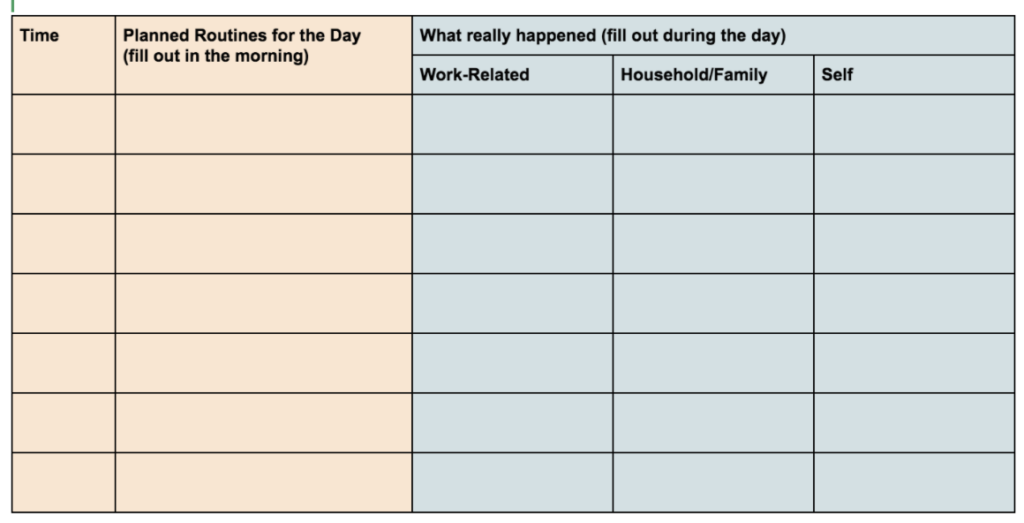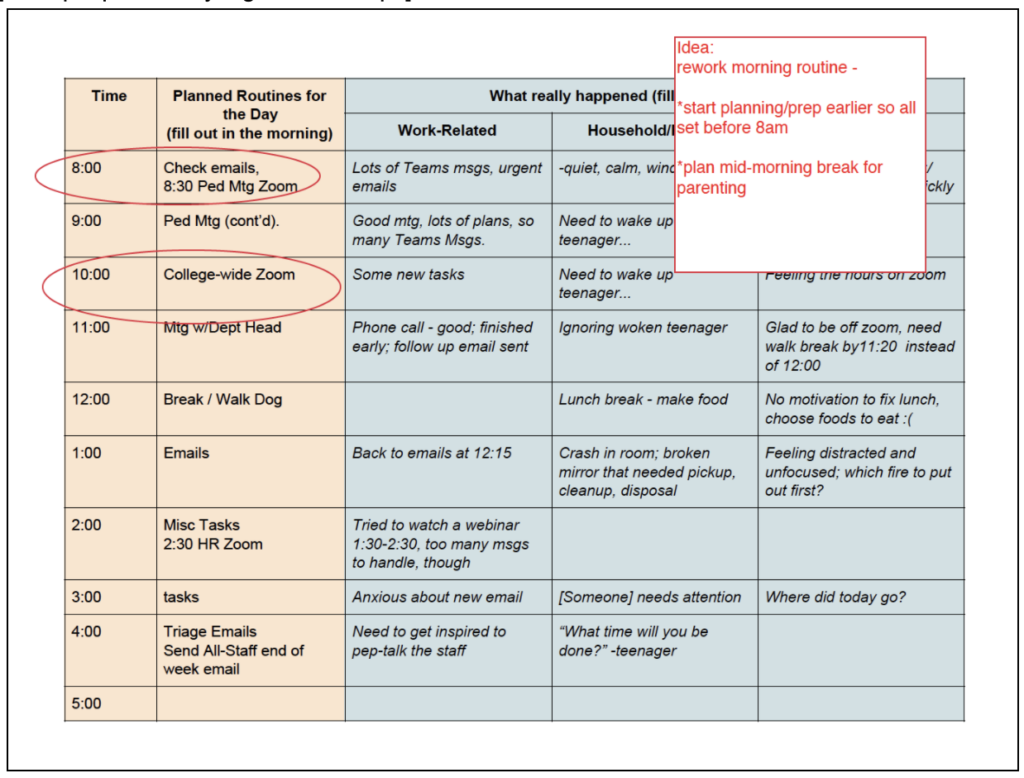 Center Director, Robyn Brookshire, offers some insight into creating daily routines that work for you and your family. Robyn is currently teleworking with her 13-year-old daughter.
Center Director, Robyn Brookshire, offers some insight into creating daily routines that work for you and your family. Robyn is currently teleworking with her 13-year-old daughter.
Routines support our daily life in so many ways. We often realize that our children thrive on routines, but maybe overlook how important routines are in our day to day adult lives. We likely set up a lot of our routines without acknowledging how important they are to us and how much they support our sense of efficacy and success every day. My morning routines are critical because they help me get a good start to the day: from the rituals around that first cup of coffee, to the rhythm and timing of the morning household schedule, to the process I use for planning and mapping out my day. These are not activities that occur by happenstance but have been built over time to create a good fit for my particular needs. We all vary to the degree to which our routines are tightly structured or loosely practiced. One of the main benefits to routines, however, is that they reduce decision-making for the repetitive activities we do every day of our work week, freeing up our minds for the important and creative tasks that we are faced within our work. I know that right now, with so many of us telecommuting as a new practice, many of those routines have been disrupted and I have definitely felt the strain of decision fatigue in the early days of working from home.
In this blog post are some simple, straightforward steps to rethinking the daily routines that can support working from home as parents, that takes into account the many roles we are playing while we juggle the demands of our households, work tasks, and parenting. The key idea behind these practices are: a balance between work and home demands, flexibility, and customization. This approach is not a suggestion to add more, do more, be more, or intensify your struggle. It’s a suggestion to pause, observe, slow down, and proceed carefully and with intention, at whatever pace you need to move. To access all the blog posts we have created for our community related to working from home and being at home with young children, visit our ELC Blog.
Document Using a Log
It’s critical right now to accept and acknowledge that we might not be as productive as normal and that our family and household demands will tug us away from work on a daily basis. Understanding and observing the needs of both our home and work lives will help inform the next best decision about how to tweak our routines. The first suggestion is to use a daily log for one to three days to get a sense of what is happening during the day and to log, a) what you’d planned/hoped to do, and b) what happened in reality. The suggested template includes columns. First, the left-hand columns can be filled out in the morning for the day ahead, with what you hope the day will look like. The remaining columns are to be tracked throughout the day to notice what was really happening during those time blocks. Columns to the right are suggested to note separately what happened with work demands, household/child demands, and your own personal needs. Everyone’s log should be very unique. Feel free to indicate if you are using very creative scheduling and not an 8-5 or 9-5 work day. When I was working full time and pursuing my masters and doctoral degrees as a parent, my work times were often at very unconventional times of the day (e.g., last night after children’s bedtime and/or early mornings before others awoke). For children’s needs, we recommend first designing routines that mirror some of the children’s usual routines (wake up times, snack times, lunchtime, nap times, bedtimes, outside times), but be ready to be flexible in tweaking the schedule moving forward.

We have another blog post that describes using this process by one of the ELC staff who is working from home with her toddler, and you can read about how she applied this strategy at home. To download a copy of the log, click here.
Interpret the Log
The next step in this process would be to finish out the log and, at some point after that day, spend a few minutes looking back at the day and interpreting the observations you made. Mark downtimes that things went well, or according to plan. Mark times when the plans fell apart and observe why this happened. This interpretation will vary highly according to each person’s log. The idea is to both acknowledge what worked so that you might continue that in your daily routine, and to recognize what didn’t work that would suggest building a new routine for those parts of the day. This step can also signal those areas in which you should consider asking for support, advice, flexibility, from any and all resources at your disposal.
See below for an example of one of my daily logs with the ideas where I notice things should be designed differently.

Revise / Redesign the Day
Now that you have some good information, find one or two areas of the day to redesign. Start small and don’t try to rebuild the entire day. Find one or two pockets where you can try something different for the next day. In my daily log example, I noticed I felt rushed at 8:00 am when the first wave of messages/emails came flooding in from my team. I decided to tweak my routine by building in some early planning/prep time between 7:00 and 8:00 so I had a chance to get my head wrapped around my priorities and plans for the day before I began responding to others. This tweak also creates some flexibility for a mid-morning break, which my log showed me was an important time for a parenting adjustment … my teenager needs support getting up and going in the morning and getting some breakfast, and supporting her morning routine will ultimately make the whole day function better for both of us. In addition to responding to others, also notice parts of the day that work well or don’t work well for your own rhythms and consider carefully placing tasks in strategic times; for instance, I know that I function better with more cognitively challenging and creative tasks earlier in the day, whereas at the end of the day I’m better suited to more passive learning and processing.
Repeat
The cycle of logging, observing, interpreting, and revising can continue as many times as it is useful to you. Going with the flow, during this strange time, means paying attention to what works well, what doesn’t, and flexibly adjusting. Logging and planning can also bring a few other benefits: it helps us acknowledge what went well when it’s often easy to just notice our failings; it can give us a sense of control in what otherwise feels like a chaotic situation; and it allows us to feel good about being responsive to our self-care needs, our children’s needs, and our work needs.
Caveat: This process may very well reveal that it’s impossible to crank out a full eight hours a day of highly productive work time that mirrors your normal work routines. That is to be expected during these times. Know that you’re not alone with that. You’ll have to make careful and hard choices about what’s most critical. Here at the ELC, we certainly advocate for paying attention to everyone’s emotional well-being during these times (adults and children alike), which might mean sacrificing some work or academic learning expectations you may be holding. We encourage you to give yourself patience, compassion, and time to figure out what the next step can be, and remind yourself that it’s okay to not have it all figured out right away.